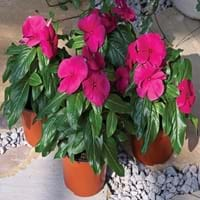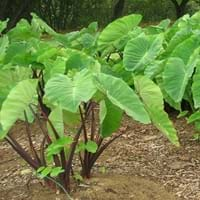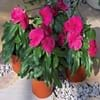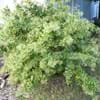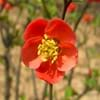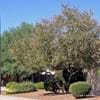Type
Tender Perennial
Tender Perennial
Origin
Hybrid origin, Madagascar
Southeastern Asia
Types
not available
Eddoe taro, Dasheen taro
Number of Varieties
Not Available
Habitat
subtropical regions, Tropical areas
agricultural areas, Hillside, Warm and moist climatic conditions
USDA Hardiness Zone
9-15
10-11
Sunset Zone
A1, A2, A3, H1, H2, 1a, 1b, 2a, 2b, 3a, 3b, 4, 5, 6, 7, 8, 9, 10, 11, 12, 13, 14, 15, 16, 17, 18, 19, 20, 21, 22, 23, 24
H1, H2, 22, 23, 24
Habit
Oval or Rounded
Clump-Forming
Flower Color
Red, Pink, Peach
White, Green
Flower Color Modifier
Bicolor
Not Available
Fruit Color
Not Available
Red
Leaf Color in Spring
Dark Green
Dark Green, Ivory
Leaf Color in Summer
Dark Green
Dark Green, Ivory
Leaf Color in Fall
Dark Green
Dark Green, Ivory
Leaf Color in Winter
Dark Green
Dark Green, Ivory
Leaf Shape
Elliptic and Ovate
V-Shaped
Plant Season
Spring, Summer, Fall, Winter
Spring, Summer, Fall, Winter
Sunlight
Full Sun, Partial Sun
Partial shade, Full Shade
Type of Soil
Clay, Loam, Sand
Loam, Sand
The pH of Soil
Neutral, Alkaline
Acidic, Neutral
Soil Drainage
Well drained
Well drained
Bloom Time
Indeterminate
Indeterminate
Tolerances
Pollution, Drought, Salt
Heat Tolerance, Humidity, Salt and Soil Compaction, Shallow soil
Where to Plant?
Ground, Pot
Container
How to Plant?
Cuttings, Seedlings
From Rhizomes
Plant Maintenance
Medium
Medium
Watering Requirements
Do not water excessively, Needs less watering, Needs small amount of water
Needs 2-3 times watering per week, Needs a lot of water initially
In Summer
Lots of watering
Lots of watering
In Spring
Moderate
Moderate
In Winter
Average Water
Average Water
Soil pH
Neutral, Alkaline
Acidic, Neutral
Soil Type
Clay, Loam, Sand
Loam, Sand
Soil Drainage Capacity
Well drained
Well drained
Sun Exposure
Full Sun, Partial Sun
Partial shade, Full Shade
Pruning
Remove damaged leaves, Remove dead branches, Remove dead leaves
No pruning needed
Fertilizers
All-Purpose Liquid Fertilizer
All-Purpose Liquid Fertilizer, Less fertilizing
Pests and Diseases
aster yellow, Leaf spot, Red blotch, Root rot, Slugs, Snails, Stem rot
Aphids, Rats, Snails
Plant Tolerance
Drought, Pollution, Salt
Heat Tolerance, Salt and Soil Compaction, Shade areas
Flowers
Showy
Insignificant
Flower Petal Number
Single
Not Available
Foliage Texture
Medium
Bold
Foliage Sheen
Glossy
Glossy
Attracts
Butterflies
Aphids, Bugs, Not Available, Snails
Allergy
Toxic if not prepared properly
Swelling in mouth, Throat itching
Aesthetic Uses
Beautification, Borders, Decorating walls, Ground Cover, Hanging Basket, Used for decorating walls, fences, gates, hedges, etc.
Showy Purposes
Beauty Benefits
Not Available
Poison Ivy, Skin cleanser, Weightloss
Edible Uses
Sometimes
Yes
Environmental Uses
Air purification, Food for animals, Food for birds
No fertilizer, pesticides, or herbicides needed, Prevent weeds
Medicinal Uses
Cancer, Diabetes, Hodgkin's lymphoma., Leukemia, Sore throat
Aging, Laxative, Weight loss
Part of Plant Used
Flowering Tips, Leaves, stalk
Leaf Stalks, Leaves
Other Uses
Decoration Purposes, Showy Purposes, Traditional medicine, Use in Chinese herbology
Used As Food, Used as Ornamental plant
Used As Indoor Plant
Sometimes
No
Used As Outdoor Plant
Yes
Yes
Garden Design
Bedding Plant, Container, Hanging Basket, Mixed Border, Tropical
Container, Feature Plant, Groundcover, Houseplant, Mixed Border, Tropical
Botanical Name
CATHARANTHUS roseus
ALOCASIA micholitziana
Common Name
Cooler Apricot Vinca, Madagascar Periwinkle, Vinca
Elephant Ear, Taro
In German
Rosafarbene Catharanthe
Colocasia (Pflanzengattung)
In French
Pervenche de Madagascar
Colocasia
In Spanish
Catharanthus roseus
Colocasia
In Greek
Catharanthus roseus
Colocasia
In Portuguese
Catharanthus roseus
Colocasia
In Polish
Katarantus różowy
Kolokazja
In Latin
Catharanthus roseus
Colocasia
Phylum
Tracheophyta
Magnoliophyta
Class
Magnoliopsida
Liliopsida
Family
Apocynaceae
Araceae
Genus
Catharanthus
Alocasia
Clade
Angiosperms, Asterids, Eudicots
Angiosperms, Monocots
Tribe
Vicieae
Colocasiodeae
Subfamily
Rauvolfioideae
Aroideae
Importance of Madagascar Periwinkle and Taro
Want to have the most appropriate plant for your garden? You might want to know the importance of Madagascar Periwinkle and Taro. Basically, these two plants vary in many aspects. Compare Madagascar Periwinkle and Taro as they differ in many characteristics such as their life, care, benefits, facts, etc. Every gardener must at least have the slightest clue about the plants he wants to plant in his garden. Compare their benefits, which differ in many ways like facts and uses. The medicinal use of Madagascar Periwinkle is Cancer, Diabetes, Hodgkin's lymphoma., Leukemia and Sore throat whereas of Taro is Aging, Laxative and Weight loss. Madagascar Periwinkle has beauty benefits as follows: Not Available while Taro has beauty benefits as follows: Not Available.
Compare Facts of Madagascar Periwinkle vs Taro
How to choose the best garden plant for your garden depending upon its facts? Here garden plant comparison will help you to solve this query. Compare the facts of Madagascar Periwinkle vs Taro and know which one to choose. As garden plants have benefits and other uses, allergy is also a major drawback of plants for some people. Allergic reactions of Madagascar Periwinkle are Toxic if not prepared properly whereas of Taro have Swelling in mouth and Throat itching respectively. Having a fruit bearing plant in your garden can be a plus point of your garden. Madagascar Periwinkle has no showy fruits and Taro has no showy fruits. Also Madagascar Periwinkle is not flowering and Taro is not flowering . You can compare Madagascar Periwinkle and Taro facts and facts of other plants too.
